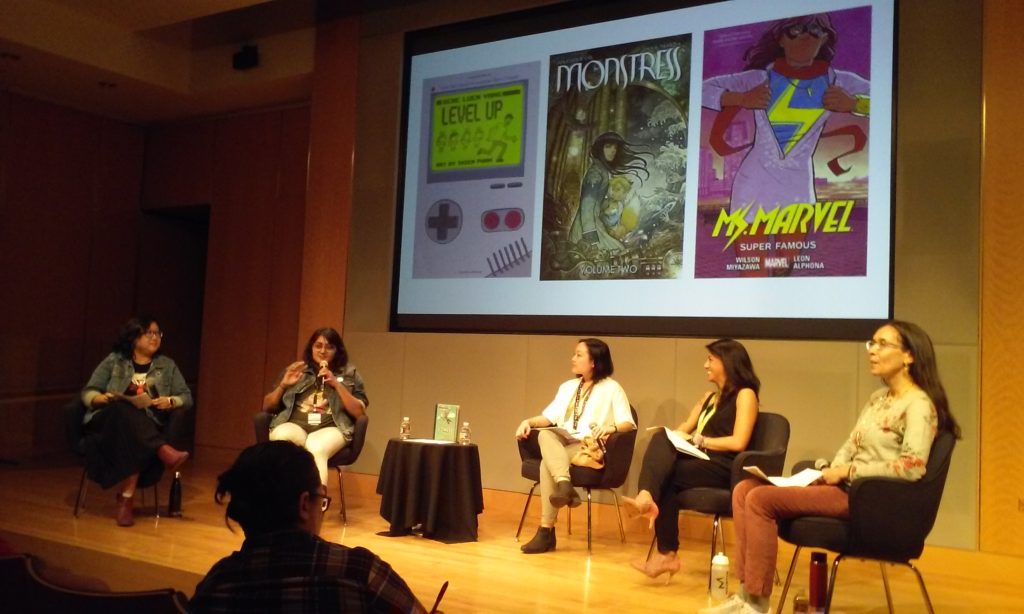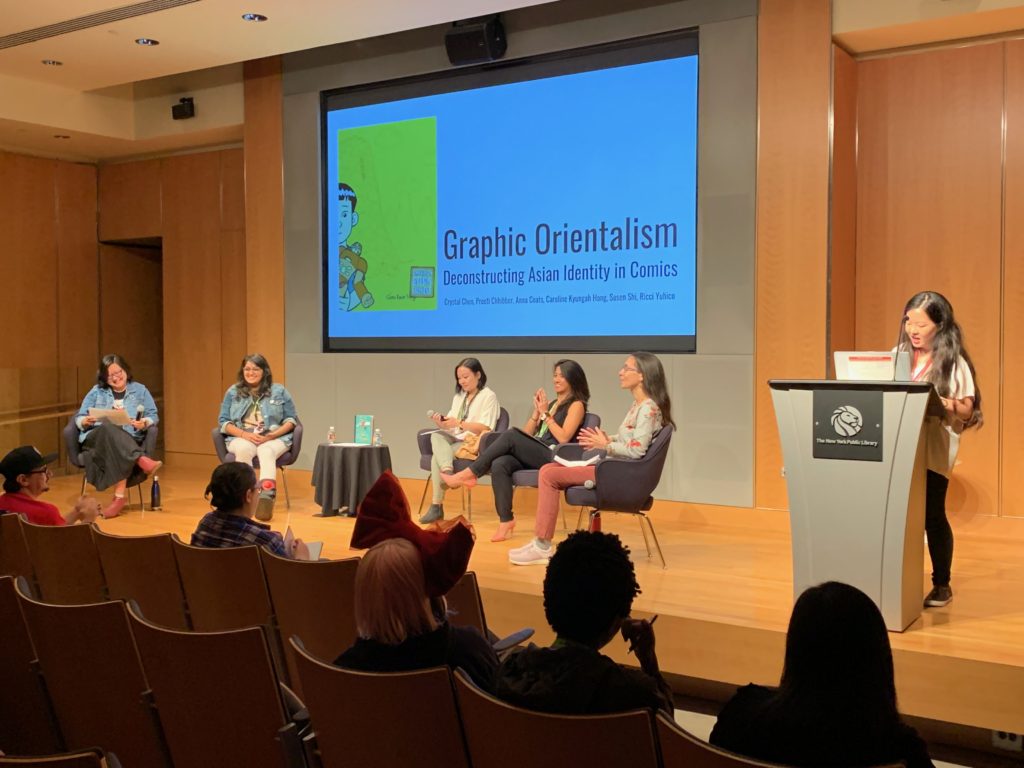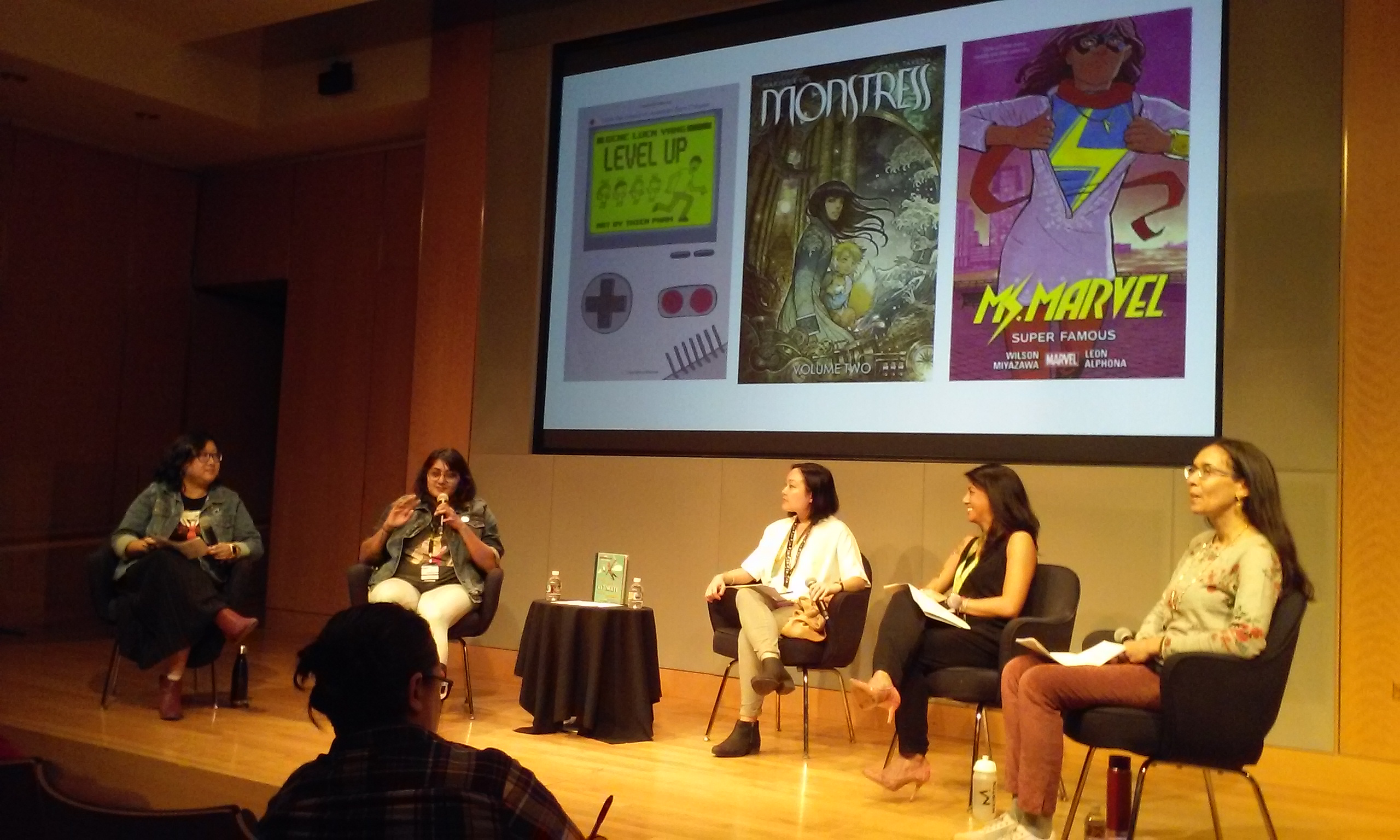by Michelle Lee
Asian and Asian American portrayals in pop culture — and the lacking and problematic versions thereof — were the point of discussion for five librarians, educators and a writer at the Graphic Orientalism: Deconstructing Asian Identity in Comics panel on October 3 during New York Comic Con Professional Day at the New York Public Library (NYPL).

The number of Asian and Asian American leads in graphic novels and films has grown over the last several years, thanks in part to more diverse writers, artists and directors, and breakouts like the Ms. Marvel comics and films like Crazy Rich Asians (2018) and The Big Sick (2017). However, the speakers said there’s room for improvement and more comics, fiction and films that explore other Asian American experiences.
The stereotype of Asian Americans being foreigners or model minorities still persists, and it is problematic, according to Preeti Chhibber, author of Spider-Man: Far from Home: Peter and Ned’s Ultimate Travel Journal.
“When you have one message on who you are and you don’t fit that message, people will question you like you’re not Indian enough,” said Chhibber, who noted that the idea of being Asian or Asian American still mainly refers to people of East Asian descent and often excludes South Asians.
Asian and Asian American men still struggle for representation and are often depicted as knowing kung fu or super-mystical Asian secrets, said Susen Shi, Mid-Manhattan Library (NYPL) young adult librarian.
Asian and Asian American women, on the other hand, are primarily portrayed as secondary characters or sex objects, or defined by their relationships to male characters, said Caroline Kyungah Hong, Queens College associate professor of English.
Bad media representations can also be hurtful. Chhibber said the racist portrayal of Indians and brownface actors she watched as a kid in the film Indiana Jones and the Temple of Doom (1984) “still haunted” her.
More than 60 people attended the hour-long talk. A slideshow of graphic novels and comics created by or featuring Asians or Asian Americans played on a large background screen, and a recommended reading list with dozens of comics, memoirs, novels, non-fiction and children’s books was provided.
Other APALA members who spoke at New York Comic Con Professional Day include: Amalia E. Butler, Maplewood (NJ) Memorial Library senior children’s librarian; Alvina Lai, a Pratt Institute School of Information graduate student, who participated in the #OwnVoices: Why Diversity Matters panel; and Miriam Tuliao, Penguin Random House marketing manager, who introduced guest speaker Sana Amanat, Marvel Comics vice president of content and character development and co-creator of Ms. Marvel.
Graphic Orientalism moderator Crystal Chen, Woodstock Library (NYPL) young adult librarian, said they organized the discussion because while the library field talks about the importance of diversity, “we don’t always engage with the difficult question of what makes good representation.”

Compared to the many comics and films featuring white protagonists, stories featuring Asian Americans are often more scrutinized and open to criticism because of their “narrative scarcity,” Hong said.
The idea that comics, novels and films can only feature one type of story is being dismantled thanks to the #OwnVoices movement with writers of color and other marginalized identities publishing books with more nuanced stories, said Ricci Yuhico, young adult services managing librarian at the Mid-Manhattan Library (NYPL).
The popular superhero Ms. Marvel/Kamala Khan, a Pakistani American teen from Jersey City, was highly praised for being realistic and multi-faceted.
“A comic’s character who reads manga and listens to Bollywood songs? Where was she when I was growing up?” said Anna Coats, Livingston (NJ) Public Library head of youth services.
Other graphic novels the panelists said “do it right” include The Best That We Could Do, by Thi Bui; One! Hundred! Demons! by Lynda Barry; The Art of Charlie Chan Hock Chye, by Sonny Liew; I Was Their American Dream, by Malaka Gharib; I Thought YOU Hated ME, by MariNaomi; and various works by Greg Pak and Gene Luen Yang.
Still, the speakers observed gaps in what kind of narratives and protagonists are published or filmed.
There are many stories featuring Asian American characters rejecting their culture, Chhibber said, yet “not enough [stories] to counter-balance that, not enough celebrations to balance both sides.”
Indo-Caribbean Americans — people of Indian heritage whose ancestors migrated to countries such as Guyana, Jamaica, Suriname and Trinidad and Tobago — are one of the largest Asian demographics in the New York City metropolitan area. Yet Coats said she’s never seen any characters with that background or other Asian Caribbean heritage depicted in comics.
The number of New York City residents born in Guyana (139,947) and Trinidad and Tobago (87,635) is higher than those born in India (76,493), according to 2010 Census and 2011 American Community Survey data (Lobo & Salvo, 2013, p. 13).
Shi and Coats explained that mental illness is another topic that needs to be in more comics and books, even though talking about it is discouraged in Asian cultures. Coats noted the suicide rates in Guyana and South Korea are among the highest in the world; they ranked the third and 10th in 2019, respectively, according to the U.N. World Health Organization (World Population Review, 2019).
There should be more comics featuring mixed-race and bi-racial characters, Yuhico said.
Yuhico and Hong also agreed there should be more stories featuring Asian American characters who are LGBT, especially tales that go beyond coming out or being bullied.
“We need more queer and trans stories — not suffering, alone or persecuted — joyful stories,” Hong said. “And more stories on disability and disability justice.”
When it came to advice for educators and librarians on how to support and promote diverse comics, the panelists suggested creating front-facing book displays and making diverse supplemental reading lists that align with the school curriculum, especially for social studies, history and literature classes.
The speakers encouraged attendees and people of color to reach out to publishers and let them know what kind of diverse stories they’d want to read.
The discussion hit a tense moment during the question-and-answer section when a white audience member asked why she was criticized by others and dropped by her literary agent for writing fiction featuring Asian, Black and Latinx characters.
The panelists could not provide a definitive answer to her situation, but they said that for years, characters of color were defined and sometimes maligned in comics and fiction created by white people, and now is the time to let other creators have a chance.
“Anyone can tell a story,” Chhibber said. She added that writers have “got to think about why you are the best person to tell it.”
Still, if writers want to create comics or fiction with characters of a different culture, ethnicity or other background, the panelists encouraged them to “do the work, do the research,” Hong said. They also encouraged writers to do the required background homework and world-building similar to writers who work in history, non-fiction and science-fiction.
“Also, it helps to bring in people of that culture to read it and talk it through,” Shi said.
References
Lobo, A. P., & Salvo, J.J. (2013). The newest New Yorkers: Characteristics of the city’s foreign-born population. New York City Department of Planning: New York City, NY. Retrieved from https://www1.nyc.gov/assets/planning/download/pdf/data-maps/nyc-population/nny2013/nny_2013.pdf
World Population Review. (2019). Suicide rate by country 2019. Retrieved from http://worldpopulationreview.com/countries/suicide-rate-by-country/

